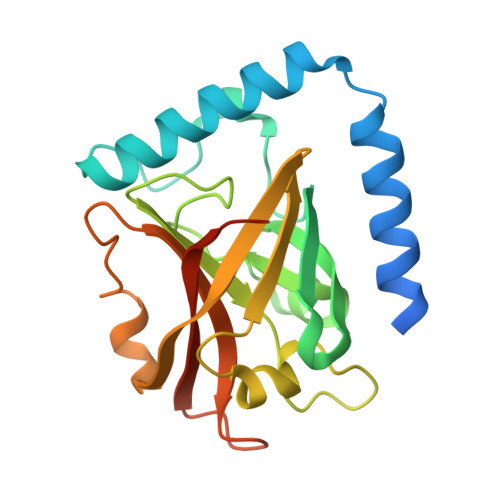X-ray structures of Clostridium perfringens sortase C with C-terminal cell wall sorting motif of LPST demonstrate role of subsite for substrate-binding and structural variations of catalytic site.
Tamai, E., Sekiya, H., Nariya, H., Katayama, S., Kamitori, S.(2021) Biochem Biophys Res Commun 554: 138-144
- PubMed: 33794418
- DOI: https://doi.org/10.1016/j.bbrc.2021.03.106
- Primary Citation of Related Structures:
7D6P, 7D6T - PubMed Abstract:
Pili of Gram-positive bacteria are flexible rod proteins covalently attached to the bacterial cell wall, that play important roles in the initial adhesion of bacterial cells to host tissues and bacterial colonization. Pili are formed by the polymerization of major and minor pilins, catalyzed by class C sortase (SrtC), a family of cysteine transpeptidases. The Gram-positive bacterium Clostridium perfringens has a major pilin (CppA), a minor pilin (CppB), and SrtC (CpSrtC). CpSrtC recognizes the C-terminal cell wall sorting signal motifs with five amino acid residues, LPSTG of CppA and LPETG of CppB, for the polymerization of pili. Here, we report biochemical analysis to detect the formation of Clostridium perfringens pili in vivo, and the X-ray structure of a novel intermolecular substrate-enzyme complex of CpSrtC with a sequence of LPST at the C-terminal site. The results showed that CpSrtC has a subsite for substrate-binding to aid polymerization of pili, and that the catalytic site has structural variations, giving insights into the enzyme catalytic reaction mechanism and affinities for the C-terminal cell wall sorting signal motif sequences.
Organizational Affiliation:
Department of Infectious Disease, College of Pharmaceutical Sciences, Matsuyama University, 4-2 Bunkyo-cho, Matsuyama, Ehime, 790-8578, Japan; Life Science Research Center and Faculty of Medicine, Kagawa University, 1750-1 Ikenobe, Miki-cho, Kita-gun, Kagawa, 761-0793, Japan.














